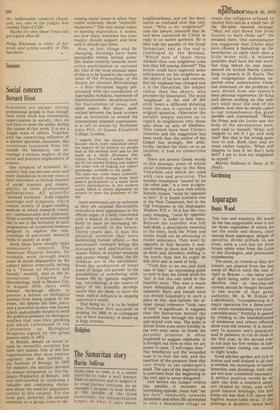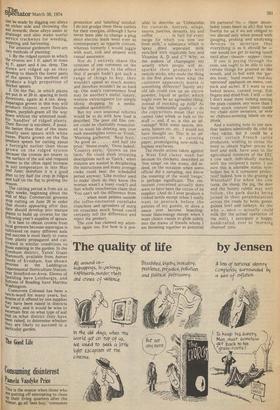Gardening
Asparagus
Denis Wood
This vain and transitory life would be the less supportable were it not for those vegetables of which we eat the stems and shoots, chief among them asparagus, delight of epicures, divine prelude to sea trout, with a cool but far from frozen white wine from the Loire or the Dordogne, and precocious strawberries.
The roots, or crowns as they are known, are planted from the last week of March until the end of April in Britain — the latter part of April being safer in northern districts. Oneor two-year-old crowns should be bought beeause, in the words of that great authority, Mr. A. W. Kidner of Lakenheath, "transplanting is a major operation for a three-yearold crown necessitating two years' convalescence." Nothing is gained by yielding to the blandishments' of seedsmen and others offering three-year-old crowns. It is necessary to possess one's gustatory soul in patience, to cut no buds in the first year, in the second year to cut only for five weeks; in subsequent years cutting can extend to eight weeks.
Good kitchen garden soil rich in humus and well drained is all that is needed; the mystiques of buried branches and dressings with salt are not now considered necessary. A perfect position would be an open one with a southern slope, not shaded by trees, and with good natural drainage, the bed being not less than 3 ft. above the highest water-table level. If the .drainage is doubtful, raised beds Can be made by digging out alleys on either side and throwing the soil inwards; these alleys assist in drainage and also make useful service trackways for weeding, Watering and harvesting. For amateur gardeners there are two methods of planting: 1. By the ridged system in which the crowns are 1 ft. apart in rows 4Z ft• apart and 4 ins. deep. The stems are ridged up as they develop to blanch the lower parts of the spears. This method will Produce a high proportion of thicker spears. 2. On the flat, in which plants are put in at 20 in. spacing in both directions, again at 4 ins. deep. Asparagus grown in this way will Produce thinner, more flexible sPears purplish-green all the way down without the whitened inedible 'handles' of ridged plants. Their flavour is excellent, if possible better than that of the more usually seen spears with white bases. Plants grown on the flat Produce spears for cutting about a fortnight earlier than those grown on the ridged system because the crowns are nearer to the surface of the soil and respond sooner to the often rapid increase in soil temperature in late May and June; therefore it is a good Plan to try half the crop in ridges and half on the flat to prolong the season.
The cutting period is from six to eight weeks, beginning about the end of May. Commercial growers stop cutting on June 20 in order that shoots appearing after that date should develop into mature Plants to build up crowns for the tollowing year's supplies of spears. It is best to obtain crowns from local growers because asparagus is Cultivated on many different soils and success is most likely to come from plants propagated and cultivated in similar conditions to those existing in the garden. In the Evesham district, Yates' Giant Mammoth, available from Asmer Seeds of Evesham, has shown Promise at the Laddington tXPerimental Horticulture Station, near Stratford-on-Avon. Elsoms of SPalding have Leinburgia, and Suttons of Reading have Martina Washington. Connovers Colossal has been a Catch-word for many years, but Strains of it offered by one supplier Illay have been raised in districts Tar away, and it would be wise to ascertain first on what type of soil and in what district they have been raised, to determine whether they are likely to succeed in a Particular garden.



































 Previous page
Previous page